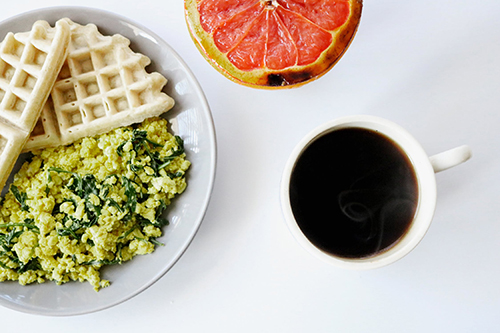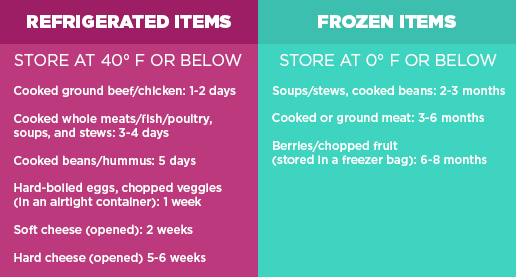Everything You Need To Know About Meal Prepping
If you are a Health Coach looking for ways to help educate your clients on meal prepping, you are in the right place!
If you’re looking for ways to simplify mealtime and eat healthier—and you do not meal prep—it’s high time to make it a habit!
Meal prepping can save you a lot of hassle when it comes to the dreaded “What should we eat?” question—not to mention saving you time and money.
Contrary to popular belief, meal prepping doesn’t have to be super complicated or eat up an entire day. (Great news for us busy folks!)
But first, what exactly does the term “meal prepping” mean?
Meal prepping is short for “meal preparation” and it’s the process of making full meals or meal components in bulk ahead of time.
8 Benefits of Meal Prepping
Using meal prepping techniques to prepare your food for the week in advance offers a number of benefits, such as:
1. Lower grocery bills – Knowing what meals you’ll be prepping in advance can save you money because you’re shopping for only the ingredients you need. Plus, you can purchase items in bulk and save additional cash.
2. Less time spent in the supermarket aisle – Have you ever walked into a grocery store, started wandering around, and somehow completely forgotten the items you came in to buy? Having a plan for your week and cooking in bulk makes for a faster grocery store visit so you can get in and out in less time. Make sure to create a list before you head inside.
3. Smarter meal choices – Meal prepping can facilitate wiser, more nutritious meal choices because you’re more intentional about what and how much you’re consuming. This leads to healthier decisions throughout your day and feeling better about yourself overall.
4. Reduced food waste – Meal prepping with only the ingredients you’ve purchased helps cut down on food waste that often stems from shopping with no plan in mind. When you know exactly what food items you need and how much, you don’t over-buy or throw away as much.
5. Better portion control – Divvying up your prepared meals into individualized portions helps teach portion control and supports weight management.
6. Reduced temptation – When you meal prep, you’re a lot less likely to reach for unhealthy meals and snacks because you already have an easy go-to meal within arm’s reach.
7. Reduced stress – Having your meals all but ready to devour can minimize that frazzled feeling that often results from having no meal plan in place. It takes a lot of time and energy thinking about what you’re going to eat every day; when you have a schedule in advance, you can spend your time on more important things, like being with loved ones or treating yourself to a self-care ritual.
8. Less time cooking – Yes, you’ll still need to cook but with meal prepping, you can prepare all of your meals in one fell swoop so you don’t have to spend as much time in the kitchen the rest of the week. You’ll actually spend less time doing dishes and cleaning up the kitchen too!
An Overview Of Top Meal Prep Methods
There are a variety of ways you can make meal prepping work for you. According to this article, a few of the most popular meal prep methods are:
Make-ahead meals – Fully cooked meals that can be stored in the refrigerator and then reheated when you’re ready to eat them.
Batch booking – Making large quantities of one recipe and then dividing them into smaller portions to eat over multiple days or freezing them for later use.
Individually-portioned meals – Portioning prepared meals into individualized portions you can grab out of the fridge on the run.
Ready-to-cook ingredients – Prepping ingredients for meals in advance to make the cooking process more efficient.
If you’re just getting started with meal prepping, you may want to pick one method to try out first, like prepping meal ingredients in advance. Once you’re comfortable with one method, you can branch out and incorporate others.
How to Meal Prep
Step 1: Pick your meal prep day(s).
Meal prepping is most efficient when you have a plan and set aside a block of time to shop, prep, and assemble your items. Sunday is a day that works for a lot of people because most people are home and can devote a chunk of time to meal prep, but of course, you should choose whatever day works best for you and your schedule. Again, we don’t recommend diving full force into meal prepping for every day of the week if you’re just getting started. In the beginning, you might just want to try meal prepping for a few days of the week.
Step 2: Choose and schedule your meals.
Decide on some simple go-to meals (emphasis on simple!) to prep based on wherever you feel like you need to streamline the most. For some people, dinnertime is the most chaotic. For others, it’s breakfast or lunch. If you do decide to prepare more than one meal, try to select meals that share ingredients. Some people find it useful to pick themes for specific meals, like Meatless Monday, Taco Tuesday, or Slowcooker Sunday. Once you’ve determined your selections, write them down in your planner or on a calendar for visibility and accountability.
Step 3: Purchase your ingredients.
Write out everything you’ll need for your meals, grouping like ingredients together so you can find what you need efficiently at the grocery store. Then head to the store to grab all of the items on your list. Or consider scheduling a pickup or grocery delivery to save yourself some time. Wherever possible, shop in bulk.
Step 4: Get the right containers.
Having the right containers on-hand is key when it comes to meal prepping. Here are a few things to look for:
- Airtight, leak-proof, durable containers that will stand up to a lot of use and abuse.
- Made of glass or BPA-free material.
- Freezer, dishwasher, and microwave-safe.
- Preferably stackable to aid in keeping your refrigerator organized.
- Containers with divided sections for storing multi-component meals.
Step 5: Assemble your ingredients.
To facilitate efficiency, organize all of your meal prep ingredients, grouping like items together in once place—like on your counter. Measure and chop anything you can in advance so items are ready to go when it’s time to cook.
Step 6: Get Cooking!
Now it’s time for the fun part—cooking! The best way to prevent meal prepping from turning into a marathon event is to multitask. Start by cooking the items with the longest prep times first. Take advantage of “down” time when items are simmering on the stove or baking in the oven, and use that time to wash fruit, chop veggies, etc.
Step 7: Store Your Meals
Once you’ve finished cooking, it’s time to store the fruits of your labor. Grab your containers, portion out your food, make sure the lid is on tight, and write the date on the container for easy reference before refrigerating or freezing (no more asking yourself, when did I make that chili??). As a rule of thumb, try to store any highly perishable foods (think fruits and veggies) in clear containers at eye-level to keep them top of mind whenever you open the fridge. If you’re freezing meals, airtight containers are generally your best bet.
Safe Meal Storage Guidelines
You worked hard to prep your food. Proper storage will ensure those efforts aren’t wasted.
First and foremost, don’t leave your freshly cooked food in a large container to cool. This can create a breeding ground for bacteria to grow and foodborne illness to ensue. Instead, immediately divide your food into smaller containers and stick them right into the fridge.
Second, if you’re storing already cooked food while you’re in the process of cooking other food, practice impeccable hygiene and be sure to wash your hands and cooking surfaces thoroughly after handling any raw meat, eggs, and fish so as not to cross-contaminate your prepared food.
Third, pay heed to the below-recommended storage and use by guidelines from the Harvard T.H. Chan School of Public Health:
6 Easy Meal Prepping Hacks
- Prep Your Staples. Save yourself some time by prepping starches, proteins, and veggies in advance to use in a variety of ways (think: chicken, quinoa, brown rice, black beans, and roasted veggies).
- Break Out Your Sheet Pan. Cut down on time, energy, and dishwashing by roasting multiple ingredients at the same time on a sheet pan.
- Use Pre-Prepped Ingredients. Rotisserie chicken, diced veggies, frozen fruit, frozen brown rice, and frozen shrimp are just a few of the ingredients that you can purchase already prepared to save you a boatload of meal prep time.
- Double Batch Cook. If you’re making something like a pasta sauce, stew, or chili, double your recipe and freeze the extra portion so you’ll have an entire extra meal at the ready when you need it.
- Make Smoothie Packs. Who doesn’t love a delicious, healthy smoothie in the morning? But they can be a bit time-consuming to prepare. On a Sunday night, prep freezer packs with all of your smoothie ingredients (greens, fruits/veggies, protein powder, nuts, seeds, etc.) so you can grab them quickly in the morning, throw them into your blender with your liquid of choice, blend, and go! Easy peasy.
- Soak Your Grains. To drastically decrease the cooking time for hearty grains like steel-cut oats and brown rice, soak them in a bowl overnight with water. This can cut cooking time practically in half and also aids indigestion.
Meal Prepping For Health Coaches
We hope this post gave you lots of food for thought for how you can turn meal prep into a healthy habit that saves you lots of time, money, and energy. As a Certified Health Coach, you can use this information to help your clients learn how to meal prep for themselves as well! Now, what are you waiting for? Time to get prepping!
Interested in learning how you can master healthy habits that serve you for life and become the healthiest version of you? Learn more about our 6-month Become a Health Coach program or connect with a Clarity Coach through the link below.
Join Health Coach Institute and Become a Health Coach
Coaching is a great career that you can help others, while also learning how to help your own personal growth. Health Coach Institute is a top health and wellness coaching certification program. Join our Become a Health Coach program and begin coaching in 6 months! If you are already a coach and want to advance your skills, check out HCI’s Coach Mastery program. Feel free to get in touch with with one of our clarity coaches directly, by calling 1-800-303-2399.
Ready to learn more?
REQUEST INFO
or call 1-800-303-2399


